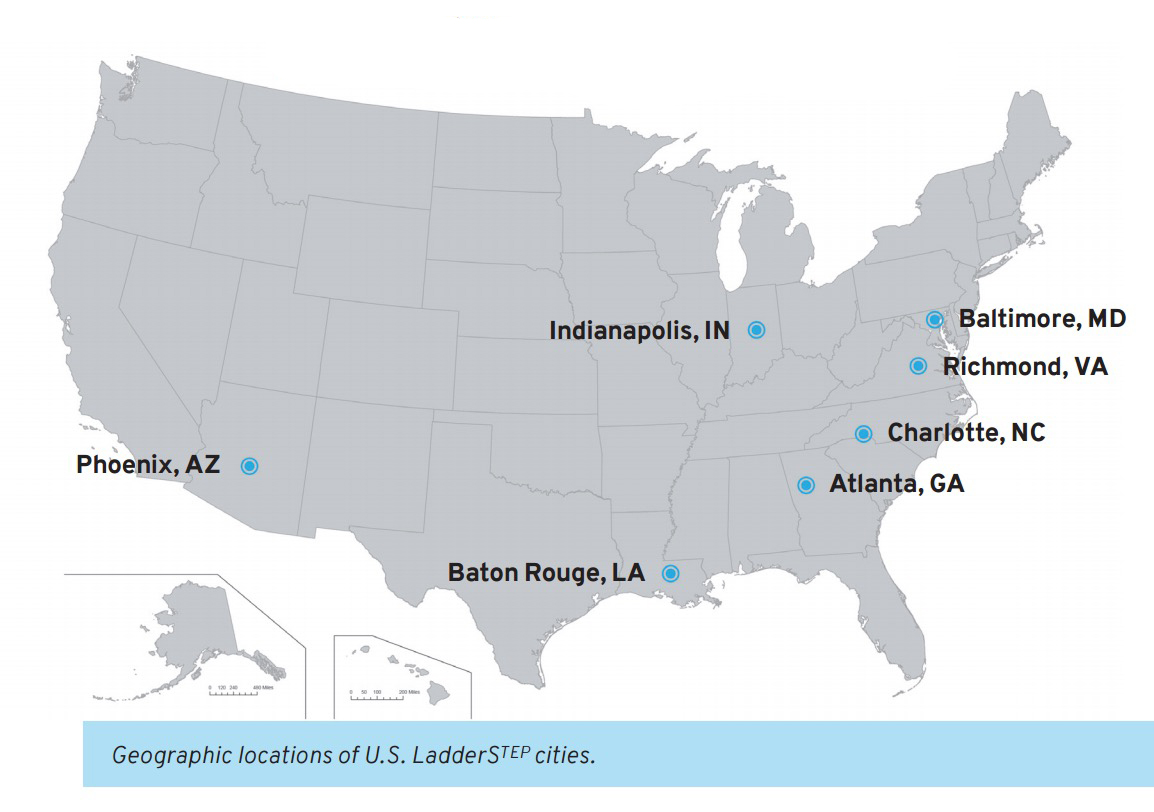UNITED STATES DEPARTMENT OF TRANSPORTATION (US DOT)
LADDERS OF OPPORTUNITY
Summary and Major Accomplishments of LadderSTEP
Transportation infrastructure choices made at the federal, state, and local levels can strengthen communities, create pathways to jobs, and improve the quality of life for all Americans. The U.S. Department of Transportation (DOT) plays a critical role in connecting Americans and communities to these opportunities. DOT’s role has typically been to directly support the states through drafting regulation, creating informational resources, and providing technical assistance and program funding. Through the Ladders of Opportunity Transportation Empowerment Pilot (LadderSTEP) model, DOT provided direct aid to cities to achieve these positive results.
This model enabled DOT to assist in connecting cities to new partners and resources, increase community and developer confidence in local projects, create inclusive stakeholder engagement networks, increase collaboration between federal partners, and enabled projects to achieve visible results quickly. The model presented some challenges—such as administrative and financial setbacks, uncertainty of how to include state DOT partners, pre-existing attitudes and community concerns, identifying a “game-changing” project, navigating federal agency roles and regulations, and resource constraints; however, LadderSTEP participants employed effective practices to overcome these hurdles. Such best practices include formally engaging a diverse set of stakeholders; establishing a DOT point of contact for cities; defining project goals and strategies early in the project development process; broadening the focus of transportation projects to include housing and economic development, among other topics; and clearly communicating the goals, challenges and successes broadly and effectively. Summarized below are the significant accomplishments achieved by cities, federal partners and Resource Groups through LadderSTEP:
In Atlanta, city and federal staff benefitted by forming new strategic partnerships with local foundations to help stimulate economic development activity in the area. A component of Atlanta’s LadderSTEP project, the Martin Luther King Jr. Drive Corridor Improvement Initiative, received a $10 million Transportation Investment Generating Economic Recovery (TIGER) 2016 grant to provide new mobility options and increase access to transit, employment centers and services. This project will continue to promote the core values of LadderSTEP once the pilot has concluded.
In Baltimore, significant achievements include acquiring funding for affordable housing on North Pulaski Street; allowing the city to adhere to its local hiring program while using federal funding on the project which employs local residents for construction; and coordinating with the Federal Railroad Administration (FRA) to avoid conflict of interest in the project area due to an on-going FRA project. Additionally, federal-level involvement in the project alleviated private investor concerns about any uncertainty of the project moving forward, which increased developer interest in the area. In West Baltimore, the North Avenue Rising Project received a $10 million TIGER 2016 grant to create a safer corridor along approximately five miles of North Avenue through pedestrian improvements, enhanced bus stops, and transit infrastructure that will increase access to employment centers and essential services for a low-income area continuing the LadderSTEP project area goals.
In Baton Rouge, the additional federal staff and technical knowledge provided through LadderSTEP enabled the city to complete the environmental review process in six months, rather than the typical 12 to 18 months. This environmental assessment is now in the public and agency review process. To help fund construction the city is seeking a Capital Investment Grant (CIG) from the Federal Transit Administration (FTA). Through LadderSTEP, FTA assisted the city in preparing a complete CIG application. On June 24, 2016 the city submitted a request to enter into the project development phase for the fiscal year 2018 CIG program.
In Charlotte, the city secured $7.7 million in city tax dollars for design work for Phase 2 of the Gold Line Streetcar project and established a partnership with the Knight Foundation who committed $1.5 million over three years to area revitalization. Furthermore, there were multiple projects occurring simultaneously and LadderSTEP served as a platform for bringing all partners together to help the city decide how to prioritize these projects.
…
Overview of LaddersTEP
DOT launched LadderSTEP in 2015 to foster sustainable economic development related to planned transportation projects. The pilot’s goal was to build and restore connections, develop workforce capacity, and catalyze neighborhood revitalization in seven cities—Atlanta, GA; Baltimore, MD; Baton Rouge, LA; Charlotte, NC; Indianapolis, IN; Phoenix, AZ; and Richmond, VA.
This report describes key achievements of each city and summarizes themes related to four topic areas:
- 1) Results and Impacts (Section V)
- 2) Obstacles (Section VI)
- 3) Best Practices (Section VII)
- 4) Recommendations for Future Work (Section VIII)
LadderSTEP is an example of a place-based initiative, which is the enhanced technical assistance to a specific region or “place” based on a set of qualifying criteria. Through LadderSTEP, DOT piloted this place-based model of providing technical assistance directly to cities to help them advance game-changing transportation projects that would promote thoughtful planning and economic growth by revitalizing, connecting, and improving access to economic opportunity.
The goals of the pilot were to:
Advance transformative investments by supporting the development of projects that help create jobs and spur smart growth economic development opportunities.
Foster strategic alliances by creating mutually beneficial public and private entity partnerships. These partnerships will ensure that the long-term public interest is protected.
Strengthen local capacity by providing technical assistance to communities by sharing expertise in advancing federally funded projects and informing communities about outside partnerships that could support project implementation.
Download full version (PDF): Transportation Empowerment Pilot
About the US DOT Ladders of Opportunity
www.transportation.gov/opportunity
he choices we make about future transportation projects, the people they touch and places they connect, will play a role in determining how widely opportunity expands throughout America. Together, we can build a stronger and more connected nation, a healthier economy, and more vibrant communities.
Tags: Ladders of Opportunity, LaddersTEP, United States Department of Transportation, US DOT







 RSS Feed
RSS Feed